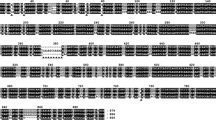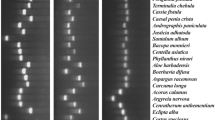Abstract
Ligularia fischeri (Gom-chi) and Ligularia stenocephala (Gon-dal-bi) are popular edible herbs in Korea. L. fischeri is used to treat jaundice, hepatitis, rheumatoid arthritis, and scarlet fever, while L. stenocephala is used to treat anxiety, weakness, and menstrual disorders. The herbal medicinal activities of these two herbs differ, but they are very difficult to distinguish based on their morphologies, especially in their dried forms. In an effort to distinguish these two plant species, we sequenced three barcoding genes in plastids, matK, rbcL, and trnH-psbA. From the analysis of sequence variations, we detected five single nucleotide polymorphisms (SNPs) between two the species. Allele specific (AS)-primers in the SNPs were employed in discrimination of the two species. Of the five AS-primer sets, one primer pair in matK gene showed reproducibly distinguishable PCR amplification between plants of L. fischeri and L. stenocephala. The method is reproducible and efficient, and is the first reported molecular method to discriminate between L. fischeri and L. stenocephala.




Similar content being viewed by others
References
Arif IA, Khan HA, Bahkali AH, Al Homaidan AA, Al Farhan AH, Al Sadoon M, Shobrak M (2011) DNA marker technology for wildlife conservation. Saudi J Biol Sci 18:219–225
Chan K (2003) Some aspects of toxic contaminants in herbal medicines. Chemosphere 52:1361–1371
Chang WT, Thissen U, Ehlert KA, Koek MM, Jellema RH, Hankemeier T, van der Greef J, Wang M (2006) Effects of growth conditions and processing on Rehmannia glutinosa using fingerprint strategy. Planta Med 72:458–467
Choi EM (2007) Ligularia fischeri leaf extract prevents the oxidative stress in DBA/1 J mice with type II collagen-induced arthritis. J Appl Toxicol 27:176–182
Drenkard E, Richter BG, Rozen S, Stutius LM, Angell NA, Mindrinos M, Cho RJ, Oefner PJ, Davis RW, Ausubel FM (2000) A simple procedure for the analysis of single nucleotide polymorphisms facilitates map-based cloning in Arabidopsis. Plant Physiol 124:1483–1492
El Beyrouthy M, Abi-Rizk A (2013) DNA Fingerprinting: the new trend in fighting the adulteration of commercialized and cultivated medicinal plants. Adv Crop Sci Technol 1:4
Ganal MW, Altmann T, Roder MS (2009) SNP identification in crop plants. Curr Opin Plant Biol 12:211–217
Ganie SH, Upadhyay P, Das S, Prasad Sharma M (2015) Authentication of medicinal plants by DNA markers. Plant Gene 4:83–99
Ha WY, Shaw PC, Liu J, Yau FCF, Wang J (2002) Authentication of Panax ginseng and Panax quinquefolius using amplified fragment length polymorphism (AFLP) and directed amplification of minisatellite region DNA (DAMD). J Agric Food Chem 50:1871–1875
Hamilton M (1999) Four primer pairs for the amplification of chloroplast intergenic regions with intraspecific variation. Mol Ecol 8:521–523
Hayashi K, Hashimoto N, Daigen M, Ashikawa I (2004) Development of PCR-based SNP markers for rice blast resistance genes at the Piz locus. Theor Appl Genet 108:1212–1220
Hebert PD, Cywinska A, Ball SL, deWaard JR (2003) Biological identifications through DNA barcodes. Proc Biol Sci 270:313–321
Hollingsworth PM, Graham SW, Little DP (2011) Choosing and using a plant DNA barcode. PLoS ONE 6:e19254
Kress WJ, Erickson DL, Jones FA, Swenson NG, Perez R, Sanjur O, Bermingham E (2009) Plant DNA barcodes and a community phylogeny of a tropical forest dynamics plot in Panama. Proc Natl Acad Sci USA 106:18621–18626
Kwok S, Chang SY, Sninsky JJ, Wang A (1994) A guide to the design and use of mismatched and degenerate primers. Genome Res 3:S39–S47
Lahaye R, van der Bank M, Bogarin D, Warner J, Pupulin F, Gigot G, Maurin O, Duthoit S, Barraclough TG, Savolainen V (2008) DNA barcoding the floras of biodiversity hotspots. Proc Natl Acad Sci USA 105:2923–2928
Lee MY, Doh EJ, Park CH, Kim YH, Kim ES, Ko BS, Oh SE (2006) Development of SCAR marker for discrimination of Artemisia princeps and A. argyi from other Artemisia herbs. Biol Pharm Bull 29:629–633
Lee BI, Nugroho A, Bachri MS, Choi J, Lee KR, Choi JS, Kim WB, Lee KT, Lee JD, Park HJ (2010) Anti-ulcerogenic effect and HPLC analysis of the caffeoylquinic acid-rich extract from Ligularia stenocephala. Biol Pharm Bull 33:493–497
Levin RA, Wagner WL, Hoch PC, Nepokroeff M, Pires JC, Zimmer EA, Sytsma KJ (2003) Family-level relationships of Onagraceae based on chloroplast rbcL and ndhF data. Am J Bot 90:107–115
Li XW, Luo Q, Gan QL (2014) Ligularia zhengyiana sp. nov. (Asteraceae) from the Hubei Province, China. Nord J Bot 32:836–838
Liu JQ (2004) Uniformity of karyotypes in Ligularia (Asteraceae: Senecioneae), a highly diversified genus of the eastern Qinghai-Tibet Plateau highlands and adjacent areas. Bot J Linn Soc 144:329–342
Liu S, Deng D, Liu J (1993) The origin, evolution and distribution of Ligularia Cass.(Compositae). Acta Phytotaxonomica Sinica 32:514–524
Luo B, Liao F, Hu Y, Liu X, He Y, Wu L, Tan H, Luo L, Zhou Y, Mo Q, et al. (2015) Acaricidal activity of extracts from Ligularia virgaurea against the Sarcoptes scabiei mite in vitro. Exp Ther Med 10:247–250
Ma XY, Xie CX, Liu C, Song JY, Yao H, Luo K, Zhu YJ, Gao T, Pang XH, Qian J et al (2010) Species identification of medicinal pteridophytes by a DNA barcode marker, the chloroplast psbA-trnH intergenic region. Biol Pharm Bull 33:1919–1924
Mishra P, Kumar A, Nagireddy A, Mani DN, Shukla AK, Tiwari R, Sundaresan V (2016) DNA barcoding: an efficient tool to overcome authentication challenges in the herbal market. Plant Biotechnol J 14:8–21
Newmaster SG, Fazekas AJ, Steeves RA, Janovec J (2008) Testing candidate plant barcode regions in the Myristicaceae. Mol Ecol Resour 8:480–490
Newton CR, Graham A, Heptinstall LE, Powell SJ, Summers C, Kalsheker N, Smith JC, Markham AF (1989) Analysis of any point mutation in DNA. The amplification refractory mutation system (ARMS). Nucleic Acids Res 17:2503–2516
Park HS, Choi HY, Kim GH (2014) Preventive effect of Ligularia fischerion inhibition of nitric oxide in lipopolysaccharide-stimulated RAW 264.7 macrophages depending on cooking method. Biol Res 47:69
Semagn K, Bjørnstad Å, Ndjiondjop M (2006) An overview of molecular marker methods for plants. Afr J Biotechnol 5:2540–2568
Shang YF, Kim SM, Song DG, Pan CH, Lee WJ, Um BH (2010) Isolation and identification of antioxidant compounds from Ligularia fischeri. J Food Sci 75:C530–C535
Shen J, Ding X, Liu D, Ding G, He J, Li X, Tang F, Chu B (2006) Intersimple sequence repeats (ISSR) molecular fingerprinting markers for authenticating populations of Dendrobium officinale Kimura et Migo. Biol Pharm Bull 29:420–422
Tate JA, Simpson BB (2003) Paraphyly of Tarasa (Malvaceae) and diverse origins of the polyploid species. Syst Bot 28:723–737
Techen N, Parveen I, Pan Z, Khan IA (2014) DNA barcoding of medicinal plant material for identification. Curr Opin Biotechnol 25:103–110
Tori M, Honda K, Nakamizo H, Okamoto Y, Sakaoku M, Takaoka S, Gong X, Shen Y, Kuroda C, Hanai R (2006) Chemical constituents of Ligularia virgaurea and its diversity in southwestern Sichuan of China. Tetrahedron 62:4988–4995
Toyoda K, Yaoita Y, Kikuchi M (2005) Three new dimeric benzofuran derivatives from the roots of Ligularia stenocephala MATSUM. et KOIDZ. Chem Pharm Bull 53:1555–1558
Wang CZ, Li P, Ding JY, Jin GQ, Yuan CS (2005) Identification of Fritillaria pallidiflora using diagnostic PCR and PCR-RFLP based on nuclear ribosomal DNA internal transcribed spacer sequences. Planta Med 71:384–386
Wang H, Sun H, Kwon WS, Jin H, Yang DC (2010) A PCR-based SNP marker for specific authentication of Korean ginseng (panax ginseng) cultivar “Chunpoong”. Mol Biol Rep 37:1053–1057
Wu QH, Wang CM, Cheng SG, Gao K (2004) Bieremoligularolide and eremoligularin, two novel sesquiterpenoids from Ligularia muliensis. Tetrahedron Lett 45:8855–8858
Xu YQ, Wang Y, Li ZZ, Bao ZX, Zhou JF, Huang HW (2006) Characterization of polymorphic microsatellite loci in a traditional Chinese medicinal plant, Gastrodia elata. Mol Ecol Notes 6:316–318
Yang DY, Fushimi H, Cai SQ, Komatsu K (2004) Polymerase chain reaction-restriction fragment length polymorphism (PCR-RFLP) and amplification refractory mutation system (ARMS) analyses of medicinally used Rheum species and their application for identification of Rhei Rhizoma. Biol Pharm Bull 27:661–669
Yao H, Song JY, Ma XY, Liu C, Li Y, Xu HX, Han JP, Duan LS, Chen SL (2009) Identification of Dendrobium species by a candidate DNA barcode sequence: the chloroplast psbA-trnH intergenic region. Planta Med 75:667–669
Yip PY, Chau CF, Mak CY, Kwan HS (2007) DNA methods for identification of Chinese medicinal materials. Chin Med 2:9
Yoo JH, Oidovsambuu S, Kim SM, Jeon NR, Yun JH, Kang K, Jho EH, Lee SB, Nho CW (2011) Hepatoprotective effect of Handaeri-gomchi (Ligularia fischeri var. spiciformis Nakai) extract against chronic alcohol-induced liver damage in rats. Food Sci Biotechnol 20:1655–1661
Acknowledgements
This study was supported by a 2014 Research Grant from Kangwon National University.
Author information
Authors and Affiliations
Corresponding author
Ethics declarations
Conflict of interest
Jin Choi, Rahul Vasudeo Ramekar, Yong Bog Kim, Se Won Kim, Hee Sun Noh, Ju Kyong Lee, Nam Il Park, Ik Young Choi, Seon-Kang Choi and Kyong Cheul Park declare that they do not have conflict of interest.
Research involving with human and animal studies
This article does not contain any studies with human subjects or animals performed by any of the authors.
Additional information
Seong Jin Choi and Rahul Vasudeo Ramekar have contributed equally to this work.
Electronic supplementary material
Below is the link to the electronic supplementary material.
Rights and permissions
About this article
Cite this article
Choi, S.J., Ramekar, R.V., Kim, Y.B. et al. Molecular authentication of two medicinal plants Ligularia fischeri and Ligularia stenocephala using allele-specific PCR (AS-PCR) strategy. Genes Genom 39, 913–920 (2017). https://doi.org/10.1007/s13258-017-0554-3
Received:
Accepted:
Published:
Issue Date:
DOI: https://doi.org/10.1007/s13258-017-0554-3




